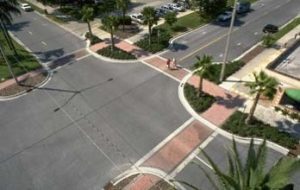Horizontal Displacement: Bulb-Outs, Neck-Downs, Mid-Block Crossings
Neck-downs, bulb-outs, chokers, and mid-block crossings are physical devices placed in the roadway to create horizontal deflections by narrowing points along the roadway.

Neck-downs, bulb-outs, chokers, and mid-block crossings are physical devices placed in the roadway to create horizontal deflections by narrowing points along the roadway. Drivers are forced to slow to negotiate the narrowed points on the roadway.
When applied on a two-lane road (each direction), these techniques can be used to narrow the lanes and slow traffic or to reduce the two lanes to one.
Narrowing of the main road section is referred to as a “choke” or “mid-block crossing” (when refuge and pavement markings are added). Narrowing at an intersection is referred to as a “neck-down” or “bulb-out.”
Advantages
- Shortens pedestrian crossing distances
- Leads to tighter turning radii and forces turning vehicles to slow
Disadvantages
- Interrupts drainage patterns at intersections and mid-block, which adds to the cost of implementation
- May be difficult for large or oversized vehicles, such as farm equipment, to negotiate
Effectiveness
An Institute of Transportation Engineers (ITE) study indicates that narrowing results in a 2.6 miles per hour (mph) speed reduction (Ewing 1999).
No crash modification factors (CMFs) were found relating to neck-downs, bulb-outs, chokers, or mid-block crossings.
Appropriateness
Devices used to narrow lanes physically should be used with caution for the types and amounts of traffic on primary roadways through small communities. Use of neck-downs, bulb-outs, chokers, and mid-block crossings may not be appropriate with heavy truck traffic and/or large farm equipment.
Cost
The uses of bulb-outs, neck-downs, chokers, and mid-block crossing have a very high cost if designing them into the roadway. A cheaper alternative is paint markings, which may have a lower effectiveness.
References
City of Winston-Salem, North Carolina. “Traffic Calming Policy. Section IV.” Traffic Calming Measures, 2003.
Ewing, Reid. Traffic Calming: State of the Practice. Washington, DC: Institute of Transportation Engineers, U.S. Department of Transportation, 1999.
